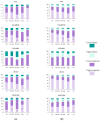Replacement of Palm Oil with Soybean Acid Oil in Broiler Chicken Diet: Fat Digestibility and Lipid Class Content along the Intestinal Tract
- PMID: 34573552
- PMCID: PMC8469231
- DOI: 10.3390/ani11092586
Replacement of Palm Oil with Soybean Acid Oil in Broiler Chicken Diet: Fat Digestibility and Lipid Class Content along the Intestinal Tract
Abstract
This study aimed to evaluate the replacement of palm oil (P) with increasing levels of soybean acid oil (SA), a by-product of soybean oil (S) refining, on lipid class content and fatty acid (FA) digestibility in the intestine and excreta of chickens at 11 and 35 days (d). Five experimental diets were obtained by supplementing a basal diet with 6% of P (P6), 6% of SA (SA6), 4% of P + 2% SA (P4-SA2), 2% of P + 4% of SA (P2-SA4) and 6% of S (S6). A total of 480 one-d-old female broiler chickens (Ross 308) were housed in metabolic cages (6 cages/treatment, with 16 birds/cage). Replacing P with SA improved fat absorption at 11 and 35 d (p < 0.05), but not feed AME values and saturated FA (SFA) digestibility at 11 d. As age increased, the absorption of SFA and free fatty acids (FFA) improved, and the contribution of the upper ileum to FA absorption increased (p < 0.05). At 35 d, SA6 (56% FFA) and P2-SA4 (40% FFA, 2.6 unsaturated-to-saturated FA ratio) could replace S6 without impairing fat utilization. The replacement of P with SA represents a suitable strategy to use this by-product.
Keywords: acid oils; broiler chickens; fat by-products; fat digestibility; free fatty acids; intestinal tract; lipid classes; poultry.
Conflict of interest statement
The authors declare no conflict of interest. The funders had no role in the design of the study; in the collection, analyses, or interpretation of data; in the writing of the manuscript, or in the decision to publish the results.
Figures


Similar articles
-
Soybean Oil Replacement by Palm Fatty Acid Distillate in Broiler Chicken Diets: Fat Digestibility and Lipid-Class Content along the Intestinal Tract.Animals (Basel). 2021 Apr 6;11(4):1035. doi: 10.3390/ani11041035. Animals (Basel). 2021. PMID: 33917521 Free PMC article.
-
Effects of dietary free fatty-acid content and saturation degree on lipid-class composition and fatty-acid digestibility along the gastrointestinal tract in broiler starter chickens.Poult Sci. 2019 Oct 1;98(10):4929-4941. doi: 10.3382/ps/pez253. Poult Sci. 2019. PMID: 31111950
-
Effects of free-fatty-acid content and saturation degree of the dietary oil sources on lipid-class content and fatty-acid digestibility along the gastrointestinal tract in broilers from 22 to 37 days of age.Poult Sci. 2021 Sep;100(9):101261. doi: 10.1016/j.psj.2021.101261. Epub 2021 May 19. Poult Sci. 2021. PMID: 34273649 Free PMC article.
-
Evolution of lipid classes and fatty acid digestibility along the gastrointestinal tract of broiler chickens fed different fat sources at different ages.Poult Sci. 2019 Mar 1;98(3):1341-1353. doi: 10.3382/ps/pey458. Poult Sci. 2019. PMID: 30307574
-
Use of re-esterified oils, differing in their degree of saturation and molecular structure, in broiler chicken diets.Poult Sci. 2015 Jul;94(7):1527-38. doi: 10.3382/ps/pev073. Epub 2015 Mar 14. Poult Sci. 2015. PMID: 25771532
Cited by
-
Influence of a Combination of Glycerol Polyethylene Glycol Ricinoleate and Bi-Distilled Oleic Acid in Powder Form on Growth Performance, Nutrient Digestibility, Excreta Nitrogen and Liver Fatty Acid Profile of Broilers Fed Reduced-Energy Diets.Animals (Basel). 2025 Mar 13;15(6):827. doi: 10.3390/ani15060827. Animals (Basel). 2025. PMID: 40150356 Free PMC article.
-
Effects of emulsifiers on lipid metabolism and performance of yellow-feathered broilers.BMC Vet Res. 2024 Jun 7;20(1):246. doi: 10.1186/s12917-024-04095-8. BMC Vet Res. 2024. PMID: 38849831 Free PMC article.
-
Olive Pomace and Soybean-Sunflower Acid Oils as Alternative Fat Sources in European Seabass (Dicentrarchus labrax) Diets: Effects on Performance, Digestibility and Flesh Fatty Acid Composition and Quality Parameters.Animals (Basel). 2022 May 6;12(9):1198. doi: 10.3390/ani12091198. Animals (Basel). 2022. PMID: 35565624 Free PMC article.
-
Influence of free fatty acid content and degree of fat saturation on production performance, nutrient digestibility, and intestinal morphology of laying hens.Anim Nutr. 2023 Mar 28;13:313-323. doi: 10.1016/j.aninu.2023.03.002. eCollection 2023 Jun. Anim Nutr. 2023. PMID: 37197305 Free PMC article.
References
-
- Statista Statista. [(accessed on 23 March 2021)]. Available online: https://www.statista.com/statistics/675815/average-prices-soybean-oil-wo...
-
- Schiavone A., Dabbou S., De Marco M., Cullere M., Biasato I., Biasibetti E., Capucchio M.T., Bergagna S., Dezzutto D., Meneguz M., et al. Black soldier fly larva fat inclusion in finisher broiler chicken diet as an alternative fat source. Animal. 2018;12:2032–2039. doi: 10.1017/S1751731117003743. - DOI - PubMed
-
- Kierończyk B., Rawski M., Józefiak A., Mazurkiewicz J., Świątkiewicz S., Siwek M., Bednarczyk M., Szumacher-Strabel M., Cieślak A., Benzertiha A., et al. Effects of replacing soybean oil with selected insect fats on broilers. Anim. Feed Sci. Technol. 2018;240:170–183. doi: 10.1016/j.anifeedsci.2018.04.002. - DOI
-
- Viñado A., Castillejos L., Barroeta A.C. Soybean lecithin as an alternative energy source for grower and finisher broiler chickens: Impact on performance, fatty acid digestibility, gut health, and abdominal fat saturation degree. Poult. Sci. 2020;99:5653–5662. doi: 10.1016/j.psj.2020.06.050. - DOI - PMC - PubMed
Grants and funding
LinkOut - more resources
Full Text Sources
Research Materials

